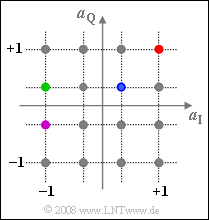Difference between revisions of "Aufgaben:Exercise 4.10Z: Signal Space Constellation of the 16-QAM"
m |
m (→Solution) |
||
| Line 62: | Line 62: | ||
===Solution=== | ===Solution=== | ||
{{ML-Kopf}} | {{ML-Kopf}} | ||
| − | '''(1)''' | + | '''(1)''' Each $\log_2 \ 16 = 4$ bits of the source signal are represented by one symbol, two bits by the four-level coefficient $a_{\rm I}$ and two more by $a_{\rm Q}$. |
| − | * | + | *Thus, the bit time is $T_{\rm B} = T/4 = 0.25 \ \rm µ s$. |
| − | * | + | *And the bit rate is then $R_{\rm B} = 1/T_{\rm B}\hspace{0.15cm}\underline { = 4 \ \rm Mbit/s}$. |
| − | '''(2)''' | + | '''(2)''' From geometry, for $a = 1 + {\rm j}$ it follows: |
:$$a| = \sqrt{1^2 + 1^2}= \sqrt{2}\hspace{0.15cm}\underline { =1.414}\hspace{0.05cm}, \hspace{0.5cm} {\rm arc}\hspace{0.15cm} a = \arctan \left ({1}/{1} \right ) \hspace{0.15cm}\underline {= 45^{\circ}}\hspace{0.05cm}.$$ | :$$a| = \sqrt{1^2 + 1^2}= \sqrt{2}\hspace{0.15cm}\underline { =1.414}\hspace{0.05cm}, \hspace{0.5cm} {\rm arc}\hspace{0.15cm} a = \arctan \left ({1}/{1} \right ) \hspace{0.15cm}\underline {= 45^{\circ}}\hspace{0.05cm}.$$ | ||
| − | '''(3)''' | + | '''(3)''' The angle is obtained as in subtask '''(2)''', the magnitude is smaller by a factor of $3$ : |
:$$|a| = \sqrt{(1/3)^2 + (1/3)^2}= \sqrt{2}\hspace{0.15cm}\underline { =0.471}\hspace{0.05cm}, \hspace{0.5cm} {\rm arc}\hspace{0.15cm} a \hspace{0.15cm}\underline {= 45^{\circ}}\hspace{0.05cm}.$$ | :$$|a| = \sqrt{(1/3)^2 + (1/3)^2}= \sqrt{2}\hspace{0.15cm}\underline { =0.471}\hspace{0.05cm}, \hspace{0.5cm} {\rm arc}\hspace{0.15cm} a \hspace{0.15cm}\underline {= 45^{\circ}}\hspace{0.05cm}.$$ | ||
| − | '''(4)''' | + | '''(4)''' For the complex amplitude coefficient $a = -1 + {\rm j}/3$ geometry gives us: |
:$$|a| = \sqrt{1^2 + (1/3)^2}\hspace{0.15cm}\underline {= 1.054}\hspace{0.05cm},\hspace{0.5cm} | :$$|a| = \sqrt{1^2 + (1/3)^2}\hspace{0.15cm}\underline {= 1.054}\hspace{0.05cm},\hspace{0.5cm} | ||
{\rm arc}\hspace{0.15cm} a = 180^{\circ} - \arctan \left ( {1}/{3} \right ) = 180^{\circ} - 18.43^{\circ} \hspace{0.15cm}\underline {= 161.57^{\circ}}\hspace{0.05cm}.$$ | {\rm arc}\hspace{0.15cm} a = 180^{\circ} - \arctan \left ( {1}/{3} \right ) = 180^{\circ} - 18.43^{\circ} \hspace{0.15cm}\underline {= 161.57^{\circ}}\hspace{0.05cm}.$$ | ||
| Line 84: | Line 84: | ||
| − | '''(5)''' | + | '''(5)''' The purple symbol $a = -1 - {\rm j}/3$ has the same magnitude as the green symbol according to subtask '''(4)''', while the phase angle changes sign: |
:$$|a| \hspace{0.15cm}\underline {= 1.054}\hspace{0.05cm},\hspace{0.5cm} | :$$|a| \hspace{0.15cm}\underline {= 1.054}\hspace{0.05cm},\hspace{0.5cm} | ||
{\rm arc}\hspace{0.15cm} a \hspace{0.15cm}\underline {= -161.57^{\circ}}\hspace{0.05cm}.$$ | {\rm arc}\hspace{0.15cm} a \hspace{0.15cm}\underline {= -161.57^{\circ}}\hspace{0.05cm}.$$ | ||
| − | '''(6)''' | + | '''(6)''' For the magnitude $N_{|a|}\hspace{0.15cm}\underline { = 3}$ different results are possible: $1.414$, $1.054$ and $0.471$. |
| − | * | + | *In contrast, there are $N_{\rm arc}\hspace{0.15cm}\underline { = 12}$ possible phase positions, namely: |
:$$ \pm \arctan (1/3) = \pm 18.43^{\circ}, \hspace{0.2cm}\pm \arctan (1) = \pm 45^{\circ}, \hspace{0.2cm}\pm \arctan (3) = \pm 71.57^{\circ}\hspace{0.05cm},$$ | :$$ \pm \arctan (1/3) = \pm 18.43^{\circ}, \hspace{0.2cm}\pm \arctan (1) = \pm 45^{\circ}, \hspace{0.2cm}\pm \arctan (3) = \pm 71.57^{\circ}\hspace{0.05cm},$$ | ||
:$$\pm (180^{\circ}-71.57^{\circ}) = \pm 108.43^{\circ}, \hspace{0.2cm}\pm (180^{\circ}-45^{\circ}) = \pm 135^{\circ}, \hspace{0.2cm}\pm 161.57^{\circ} \hspace{0.05cm}.$$ | :$$\pm (180^{\circ}-71.57^{\circ}) = \pm 108.43^{\circ}, \hspace{0.2cm}\pm (180^{\circ}-45^{\circ}) = \pm 135^{\circ}, \hspace{0.2cm}\pm 161.57^{\circ} \hspace{0.05cm}.$$ | ||
Revision as of 17:15, 19 March 2022
We now consider the 16-QAM method according to the block diagram given in the theory section. The diagram shows the possible complex amplitude coefficients $a = a_{\rm I} + {\rm j} · a_{\rm Q}$.
As in Exercise 4.10 , the following should be assumed:
- The possible amplitude coefficients $a_{\rm I}$ and $a_{\rm Q}$ of the two component signals are $ ±1$ and $±1/3$, respectively.
- The fundamental transmission pulse $g_s(t)$ is rectangular with amplitude $g_0 = 1\ \rm V$ and duration $T = 1 \ \rm µ s$.
- The source signal $q(t)$ before the serial-to-parallel converter is binary and redundancy-free.
Hints:
- This exercise belongs to the chapter Quadrature Amplitude Modulation.
- The page Quadratic QAM signal space constellations is helpful for completing this exercise.
- The signals belonging to the colored points are shown in the same colors as in Exercise 4.10.
Questions
Solution
- Thus, the bit time is $T_{\rm B} = T/4 = 0.25 \ \rm µ s$.
- And the bit rate is then $R_{\rm B} = 1/T_{\rm B}\hspace{0.15cm}\underline { = 4 \ \rm Mbit/s}$.
(2) From geometry, for $a = 1 + {\rm j}$ it follows:
- $$a| = \sqrt{1^2 + 1^2}= \sqrt{2}\hspace{0.15cm}\underline { =1.414}\hspace{0.05cm}, \hspace{0.5cm} {\rm arc}\hspace{0.15cm} a = \arctan \left ({1}/{1} \right ) \hspace{0.15cm}\underline {= 45^{\circ}}\hspace{0.05cm}.$$
(3) The angle is obtained as in subtask (2), the magnitude is smaller by a factor of $3$ :
- $$|a| = \sqrt{(1/3)^2 + (1/3)^2}= \sqrt{2}\hspace{0.15cm}\underline { =0.471}\hspace{0.05cm}, \hspace{0.5cm} {\rm arc}\hspace{0.15cm} a \hspace{0.15cm}\underline {= 45^{\circ}}\hspace{0.05cm}.$$
(4) For the complex amplitude coefficient $a = -1 + {\rm j}/3$ geometry gives us:
- $$|a| = \sqrt{1^2 + (1/3)^2}\hspace{0.15cm}\underline {= 1.054}\hspace{0.05cm},\hspace{0.5cm} {\rm arc}\hspace{0.15cm} a = 180^{\circ} - \arctan \left ( {1}/{3} \right ) = 180^{\circ} - 18.43^{\circ} \hspace{0.15cm}\underline {= 161.57^{\circ}}\hspace{0.05cm}.$$
(5) The purple symbol $a = -1 - {\rm j}/3$ has the same magnitude as the green symbol according to subtask (4), while the phase angle changes sign:
- $$|a| \hspace{0.15cm}\underline {= 1.054}\hspace{0.05cm},\hspace{0.5cm} {\rm arc}\hspace{0.15cm} a \hspace{0.15cm}\underline {= -161.57^{\circ}}\hspace{0.05cm}.$$
(6) For the magnitude $N_{|a|}\hspace{0.15cm}\underline { = 3}$ different results are possible: $1.414$, $1.054$ and $0.471$.
- In contrast, there are $N_{\rm arc}\hspace{0.15cm}\underline { = 12}$ possible phase positions, namely:
- $$ \pm \arctan (1/3) = \pm 18.43^{\circ}, \hspace{0.2cm}\pm \arctan (1) = \pm 45^{\circ}, \hspace{0.2cm}\pm \arctan (3) = \pm 71.57^{\circ}\hspace{0.05cm},$$
- $$\pm (180^{\circ}-71.57^{\circ}) = \pm 108.43^{\circ}, \hspace{0.2cm}\pm (180^{\circ}-45^{\circ}) = \pm 135^{\circ}, \hspace{0.2cm}\pm 161.57^{\circ} \hspace{0.05cm}.$$
